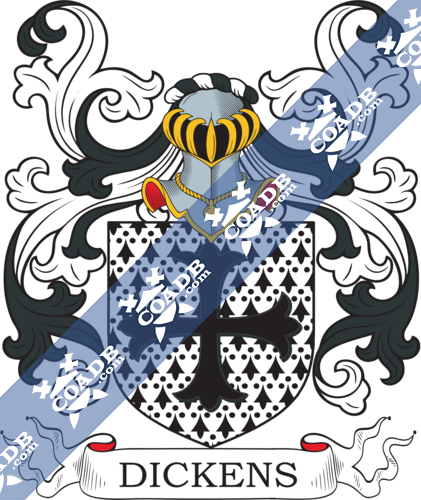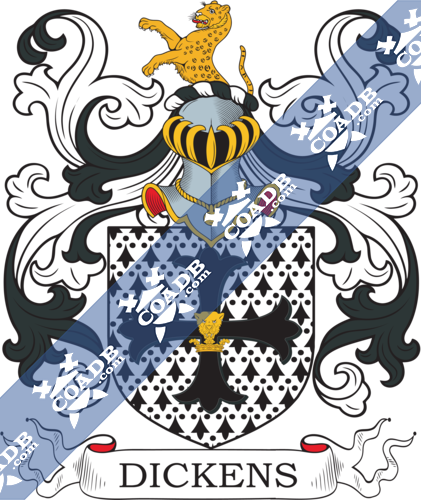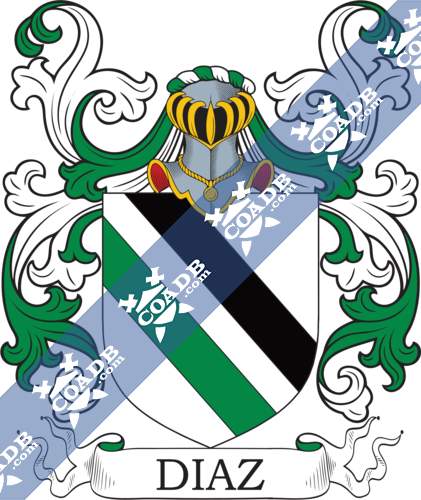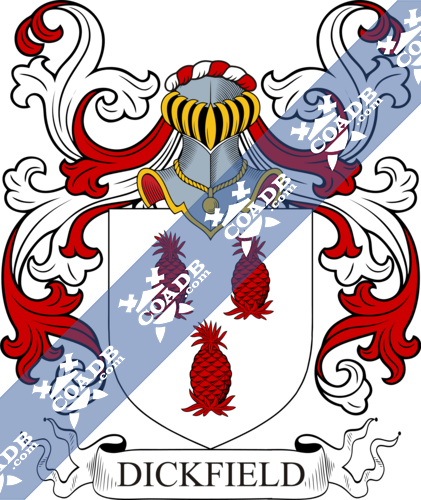Dickens Family Crest, Coat of Arms and Name History

Dickens Coat of Arms Gallery
Don’t know which Coat of Arms is yours?
We can do a genealogical research. Find out the exact history of your family!
Learn MoreDICKENS
Dickens is a surname which originated in the given name of Richard, and the patronymic of ‘Son of.’ Richard is an Anglo-Saxon name which came to England via the Saxon, and Jute invasions of England in 7th and 8th centuries. Henry II’s successor and heir to the English throne was the legendary Richard I. King Richard III of Shakespearean infamy and leader of the House of York during the War of the Roses both were addressed as Dickon, shortening of their given name. Richardson or son of Richard became shortened to Dickenson. Eventually as the English language evolved and matured, this shortened to Dickens.
Surnames in Britain prior to the Norman conquest were largely unheard of. In the small settlements and villages which existed during earlier times, residents found little need for surnames as everyone in these communities new each other and a given name would usually suffice. However, with the passage of time, population growth and expansions of communities as villages gave way to towns and cities, it became necessary to add a qualifier to a people’s names to distinguish them, one from another. Therefore one person may have been identified by their given name plus their occupation while another may have been identified by their given name and one of their parent’s names. The introduction of surnames by the Norman aristocracy after the invasion seemed to be the next logical step in this evolution. There was a boundless supply from which surnames could be formed, in addition to the use of patriarchal/matriarchal names or reference to the individuals occupation, there were things such as defining physical traits, a familiar geographical location or a topographical landmark found near the individuals home or birthplace, the name of the village in which the person lived, and so much more. Soon, surnames would come not just to represent an individual but whole families.
There often exists variations in spelling of many surnames, as with many given names which date back to the early centuries. The variation in spelling of both given and surnames during this time period can be attributed to a lack of continuity regarding guidelines for spelling which was compounded by the diversity of languages in use in European countries at this time. The variations in the spelling of the surname are often times based on the literacy of the person writing the names.
In the various tax rolls enacted by Henry II and other monarchs from that point forward, spellings of one name could vary from census to census and county to county, simply having a different clerk write them down. The other sad reality of the medieval era was unless a woman was of high birth, or had acquired some form of wealth on her own, it wasn’t until the end of the medieval period in the late 15th century where female names appeared, making it very difficult to track the history of a family.
Possible spellings of the name can be found as Dixson; Dickson; Dickenson, and Dicksen. The earliest version of the surname Dickens is a Dicum who is listed in a revolt in the Anglo-Saxon chronicles of 911 AD. Because of the popularity of the surname, it can be found in almost all counties of England. As the nascent British empire spread, so did the Dickens name. The Irish plantation system in Ulster, Northern Ireland was populated by English farmers and craftsmen, which gave rise to the Irish immigrants who came to America and Canada after the 1840’s. Thomas Dickin is listed as one of the high sheriff’s of Shropshire, in 1799.
Charles Dickens, is arguably the most famous holder of the surname. He was the second of eight children born in Portsmouth, England the son of a John Dickens who was a clerk for the Royal Navy. Charles’ father although a hard worker, had absolutely no business sense or the ability to not spend money. When Charles was 12 years old the family were shipped off to a debtors prison/work house to pay off a forty pound debt his father owed. It became one of the pivotal moments in his life, and led him to crusade against one of the worst ills of early Victorian society, namely that of debtors prisons. It also marked a turning point in his life, as he vowed to never fall into debt. Charles Dickens, is considered one of the most important writers of the 19th century. He was the first successful writer of the English language to have his stories serialized in newspapers, building an audience and a following who would buy his serialized stories in book form. This was a pattern many 19th and 20th century writers would follow, not least among them Winston Churchill in his early literary efforts.
His most autobiographical endeavor, which hit the closest to his working class roots, was ‘David Copperfield.’ At the age of twenty four Dickens married Catherine Hogarth, and in the course of time they had ten children. His grandchildren and great, great grandchildren, are found in Australia, Canada, England and the United States. They include writers, actors, and Royal Navy officers (One rear Admiral one Captain, and one serving officer.)
Blazons & Genealogy Notes
1) (Southbridge House). Motto—Semper fidelis. Erm. a cross flory az. charged with four cinquefoils and in the centre a leopard’s face ar. Crest—On a mount a lion sejant sa. holding in the dexter paw a cross flory az.
2) (co. Stafford). Erm. a cross patonce sa.
3) (Scrase-Dickens, Coolhurst, co. Sussex; Cherrington, co. Warwick). granted by Segar, Garter 1525. also granted by Segar, in 1616. 4) Erm. on a cross flory sa. a leopard’s face or; quarterly with Scrase, viz., az. a dolphin naiant ar. fins or, betw. three escallops of the last. Crests— 1st: A lion sejant sa. holding in the dexter paw a cross flory or, for Dickins; 2nd: On the stump of a tree entwined by a serpent ppr. a falcon volant, also ppr. beaked, membered, and belled or, for Scrase.
5) Erm. a cross patonce sa. a canton gu. Crest—An arm in armour couped in fesse from the elbow in pale, holding up an esquire’s helmet all ppr.
6) Bendy of six erm. and gu.
7) (Leaton and Bobbington, co. Stafford; Churchill and Great Malvern, co. Worcester). Erm. a cross patoncee sa.
8) (London; granted 16 June, 1625). Erm. on a cross patonce sa. a leopard’s head or. Crest—A lion couchant or, holding out in the gamb a cross patonce sa.
9) Motto—Hostis honori invidia. Erm. on a cross patonce sa. a leopard’s head issuing out of a ducal coronet or. Crest—A demi leopard erect ppr.














